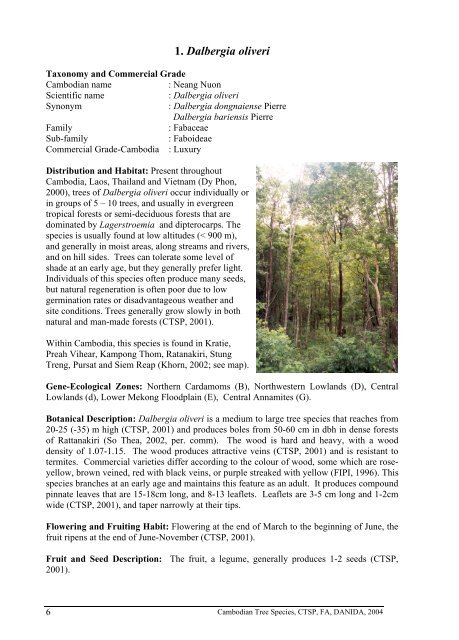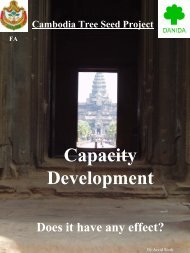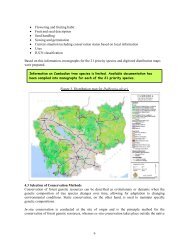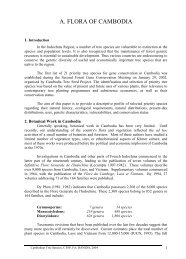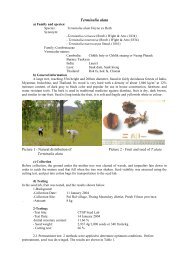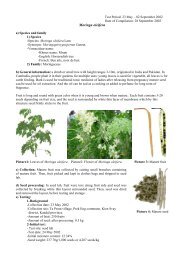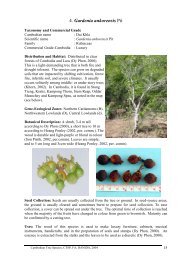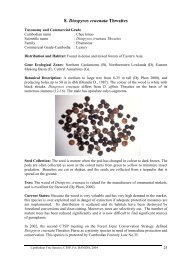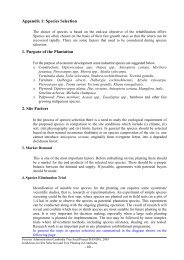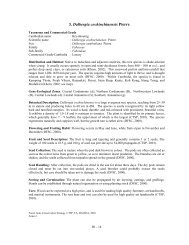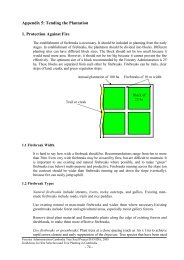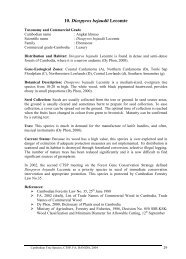Dalbergia oliveri - Cambodia Tree Seed Project
Dalbergia oliveri - Cambodia Tree Seed Project
Dalbergia oliveri - Cambodia Tree Seed Project
You also want an ePaper? Increase the reach of your titles
YUMPU automatically turns print PDFs into web optimized ePapers that Google loves.
1. <strong>Dalbergia</strong> <strong>oliveri</strong><br />
Taxonomy and Commercial Grade<br />
<strong>Cambodia</strong>n name<br />
: Neang Nuon<br />
Scientific name<br />
: <strong>Dalbergia</strong> <strong>oliveri</strong><br />
Synonym<br />
: <strong>Dalbergia</strong> dongnaiense Pierre<br />
<strong>Dalbergia</strong> bariensis Pierre<br />
Family<br />
: Fabaceae<br />
Sub-family<br />
: Faboideae<br />
Commercial Grade-<strong>Cambodia</strong> : Luxury<br />
Distribution and Habitat: Present throughout<br />
<strong>Cambodia</strong>, Laos, Thailand and Vietnam (Dy Phon,<br />
2000), trees of <strong>Dalbergia</strong> <strong>oliveri</strong> occur individually or<br />
in groups of 5 – 10 trees, and usually in evergreen<br />
tropical forests or semi-deciduous forests that are<br />
dominated by Lagerstroemia and dipterocarps. The<br />
species is usually found at low altitudes (< 900 m),<br />
and generally in moist areas, along streams and rivers,<br />
and on hill sides. <strong>Tree</strong>s can tolerate some level of<br />
shade at an early age, but they generally prefer light.<br />
Individuals of this species often produce many seeds,<br />
but natural regeneration is often poor due to low<br />
germination rates or disadvantageous weather and<br />
site conditions. <strong>Tree</strong>s generally grow slowly in both<br />
natural and man-made forests (CTSP, 2001).<br />
Within <strong>Cambodia</strong>, this species is found in Kratie,<br />
Preah Vihear, Kampong Thom, Ratanakiri, Stung<br />
Treng, Pursat and Siem Reap (Khorn, 2002; see map).<br />
Gene-Ecological Zones: Northern Cardamoms (B), Northwestern Lowlands (D), Central<br />
Lowlands (d), Lower Mekong Floodplain (E), Central Annamites (G).<br />
Botanical Description: <strong>Dalbergia</strong> <strong>oliveri</strong> is a medium to large tree species that reaches from<br />
20-25 (-35) m high (CTSP, 2001) and produces boles from 50-60 cm in dbh in dense forests<br />
of Rattanakiri (So Thea, 2002, per. comm). The wood is hard and heavy, with a wood<br />
density of 1.07-1.15. The wood produces attractive veins (CTSP, 2001) and is resistant to<br />
termites. Commercial varieties differ according to the colour of wood, some which are roseyellow,<br />
brown veined, red with black veins, or purple streaked with yellow (FIPI, 1996). This<br />
species branches at an early age and maintains this feature as an adult. It produces compound<br />
pinnate leaves that are 15-18cm long, and 8-13 leaflets. Leaflets are 3-5 cm long and 1-2cm<br />
wide (CTSP, 2001), and taper narrowly at their tips.<br />
Flowering and Fruiting Habit: Flowering at the end of March to the beginning of June, the<br />
fruit ripens at the end of June-November (CTSP, 2001).<br />
Fruit and <strong>Seed</strong> Description: The fruit, a legume, generally produces 1-2 seeds (CTSP,<br />
2001).<br />
6<br />
<strong>Cambodia</strong>n <strong>Tree</strong> Species, CTSP, FA, DANIDA, 2004
<strong>Seed</strong> Collection: The seed is mature when the pod has changed in colour to dark brown.<br />
However, the beans can also be collected as soon as the pod turns from green to yellow in<br />
order to minimize insect predation. <strong>Seed</strong>s are collected with a tarpaulin underneath the tree as<br />
the branches are shaken or cut. Maturity can be confirmed by a cutting test.<br />
Uses: Easy to polish, the wood is widely used for making high quality furniture, luxury<br />
cabinets, art and handicrafts, decorations etc.<br />
Current Status: Due to its economic value, <strong>Dalbergia</strong> <strong>oliveri</strong> is facing serious depletion by<br />
illegal cutting. The number of remaining individual trees is very low, and these are<br />
disappearing on a local level. In many areas of its natural range, mature and large sized trees<br />
are rarely to be found. Efforts to regenerate the species on a large scale have been few and<br />
limited. The species is facing the possibility of extinction if no effective protection measures<br />
are taken (CTSP, 2001).<br />
In 2002, the second CTSP meeting on the Forest Gene Conservation Strategy defined<br />
<strong>Dalbergia</strong> <strong>oliveri</strong> as a priority species, and one that is in need of immediate conservation<br />
interventions and appropriate protection. This species is protected by <strong>Cambodia</strong>n Forestry<br />
Law No.35.<br />
IUCN Classification: EN A1cd<br />
References:<br />
‣ <strong>Cambodia</strong>n Forestry Law No. 35, 25 th June 1988<br />
‣ CTSP, <strong>Cambodia</strong> <strong>Tree</strong> <strong>Seed</strong> <strong>Project</strong>, 2001, Some Endangered Species of <strong>Cambodia</strong>,<br />
unpublished<br />
<strong>Cambodia</strong>n <strong>Tree</strong> Species, CTSP, FA, DANIDA, 2004 7
‣ FA, 2002 (draft), List of Trade Names of Commercial Wood in <strong>Cambodia</strong>, Trade<br />
Names of Commercial Woods, unpublished<br />
‣ FIPI. Forest Inventory and Planning Institute, 1996, Vietnam Forest <strong>Tree</strong>s<br />
‣ Khorn, S, 2002, Distribution of Selected <strong>Tree</strong> Species for Gene Conservation in<br />
<strong>Cambodia</strong><br />
‣ Ministry of Agriculture, Forestry and Fisheries, 1986, Decision No. 050 SSR.KSK:<br />
Wood Classification and Minimum Diameter for Allowable Cutting, 12 th September<br />
‣ So Thea, Manager of CTSP, 2002 pers.comm.<br />
‣ The UNEP World Conservation Monitoring Centre, 2002, Red List for <strong>Cambodia</strong>,<br />
‣ CTSP Seminar, 29 Jan. 2002 on Forest Gene Conservation Strategy<br />
8<br />
<strong>Cambodia</strong>n <strong>Tree</strong> Species, CTSP, FA, DANIDA, 2004


